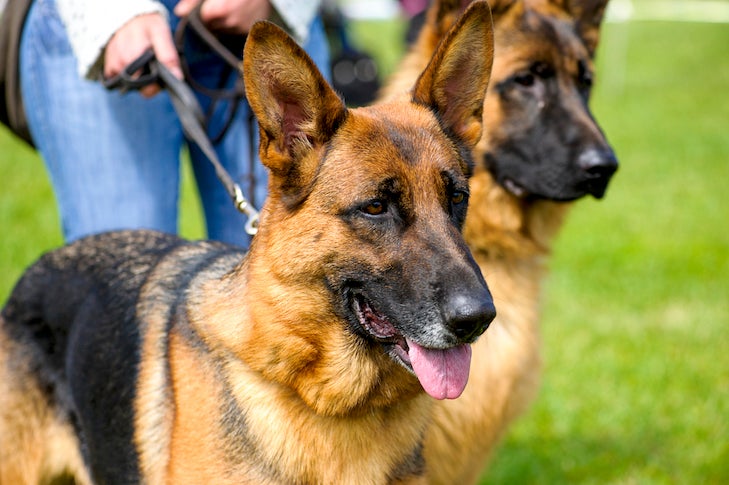
Sixty-nine million U.S. households owned a dog in 2020, according to a recent survey by the American Pet Products Association (APPA). Slightly more than one-quarter of dog owners provide homes to more than one dog.
You’ve probably heard it said by devoted dog owners – dogs are just like potato chips; you can’t have just one. Having a second dog is hard to resist. But anyone considering adding a second dog to their household should be sure to do the math, because owning two dogs will approximately double the cost of one.
What Are the Benefits?
The 2021-2022 APPA National Pet Owners Survey revealed that owning multiple dogs is more common in the Western U.S. and less common in the Northeast. Gen X and Gen Z are the age groups most likely to own two dogs. And one-quarter of women dog owners reported having two dogs.
What made these people take the leap to multiple dog ownership? The top reason given by 56 percent of respondents is that two dogs can be companions for each other. Almost half say multiple dogs make the household more fun. And 42 percent like the added companionship for the human members of the household.
Other reasons those surveyed list for getting a second dog include the opportunity to rescue another dog from a shelter, health benefits multiple dogs provide to their owners, and the desire to keep bonded dogs together.
What Are the Additional Costs?
Sometimes dog lovers think they can double their pleasure without doubling their costs. However, whether you buy a puppy or rescue a shelter dog, that dog will come with some expense requirements throughout his or her lifetime that a responsible dog owner can’t avoid.
The Kiplinger Newsletter reported that “in the first year alone, your new best friend can cost between $700 and $2,000 excluding any special needs, such as dog walking, pet insurance, and grooming, which can raise the cost by more than $7,000. In the following years, your annual expenses may decrease slightly, or they could increase significantly.”

A second dog will at least double your veterinary costs, and if the dog has health problems or is accident prone, those costs could triple or more. The APPA survey showed an increase in the number of dog owners who took their dogs to the vet three or more times in the past year. For routine visits including vaccines, that’s an average of $242 per visit, while emergency visits can average $359 and reach as high as $800 or more. Close to 80 percent of owners reported that their dog was spayed or neutered – an additional veterinary cost of $50-to-$300.
The average amount dog owners spend on food for their pets has increased in the last few years, with one-third feeding premium dog food. Estimated costs for food per dog range from $275-to- $800 annually.
Some people may rationalize that multiple dogs can share supplies to keep costs down – beds, toys, bulk dog food, grooming tools, for example. But the reality is that any savings is more than offset by additional expenses. Dog care supplies and services have increased in price in the past few years, including dog beds, crates, carriers, heartworm preventatives, insurance, and flea and tick treatments. If you have your dogs groomed, walked by pet sitters, boarded when you travel, or schooled by professional trainers, the cost of a second dog can increase your pet care costs significantly.
How Can I Prepare for Adding a Dog to My Household?
Even if you have your heart set on getting another dog, you may decide that the time isn’t right to add the cost of another dog to your expenses. However, it may be exactly the right time to step up your savings, so you’ll be prepared for the added expense and increased pleasure of a multiple-dog household in the future.
Ask Yourself These Questions:
- What am I currently spending on one dog each year?
- What are the estimated expenses of adding a puppy or an older dog to my household for the first year?
- What are my estimated costs every year following during each dog’s life?
- Do I have the funds to cover unexpected costs such as surgery or boarding, if necessary?
- Do I have the time to care for, train, and exercise two dogs?
- How much money do I need to save every month before I have the finances I need to pay for the estimated costs of two dogs?
Dogs can be expensive. They’re also amazing companions who add love and joy to our lives. But don’t make a spur-of-the-moment decision because you see an adorable furry face on the Internet, or your breeder has a new litter of pups. Saving the money you’ll need beforehand is the best way to prepare to handle the expense of adding a new best friend to your household.
Financial preparedness is a part of responsible dog ownership, and the right banking products can make a big difference. Savings Connect from CIT Bank helps you boost savings and earn more when you bundle with a linked eChecking account. With a Savings Connect account, you can access your accounts 24/7 online, through the CIT Bank mobile app, or through any U.S. ATM with your eChecking debit card. CIT doesn’t charge ATM fees and reimburses up to $30 in other U.S bank’s ATM fees on your eChecking account. With Savings Connect, owners can focus less on finances and more on spending quality time with their dogs. CIT Bank, N.A. is a member of the FDIC.

